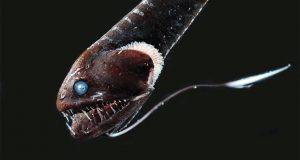The ongoing battle between predator and prey has led to unique adaptations for both sides, one being camouflage. This can clearly be seen in an organism like the cuttlefish who has the ability to change the color of its skin to match the color of its background. Recently a group of scientists has been looking at camouflage in deep sea organisms. Previously deep sea organisms were observed having translucent or reflective bodies which provided camouflage due to the extreme low light level. In the dark of the deep ocean a translucent organism can reflect a little at 0.4% of light making it almost invisible, furthermore a reflective fish has so little light to reflect at these depths that it too appears to match the background color. However these were not the adaptation that these researchers were looking into, instead they examined what they call “super black” organisms. These are organisms which reflect less than 0.5% of the light they interact with. This leads to the questions of why do these organisms have this adaptation and how do these organisms reflect this little light.
The simple answer to why these organisms reflect so little light is that we don’t really know. The researchers studied 16 different fish species across seven different orders of fish. This means that each organism probably has its own unique reason for this adaptation. One reason the researchers think this adaptation came around is the high use of bioluminescence by organisms in this environment, while biolumeces has multiple uses, if an organism interacts with this light in the wrong way it can become easily visible for other organisms in this environment. While translucent organisms can reflect as little as 0.5% of light this can still be enough for the organism to be detected. One of the fish species that the researchers examined was a bait fish, this is a fish like the anglerfish which uses bioluminescence to attract prey. The researchers hypothesize that a fish like this could use its low reflective properties in order for it’s body to not be detected by its prey when it’s using bioluminescence, however more research needs to be done on why these organisms have this super dark coloring.

Idiacanthus antrostomus a baitfish with “super black” skin by K. Osborn/Smithsonian National Museum of Natural History
These organisms achieve “super black” through a pigment on their skin called melanin, which is organized in an organelle called the melanosomes. A melanosome can absorb up to 99.95% of light, however these fish’s skin contain layers of these melanosomes which can be seen below. This allows light which is reflected from one melanosome to be absorbed by a different melanosome. This system for achieving such a high level of light absorption is much simpler than other mechanisms found in nature such as birds or butterflies, meaning that scientists could use it as an easier way of producing a system a high level of light absorption which are used in solar power generators, radiometers, industrial baffles and telescopes.

Electron microscope image of melanosomes in deep sea fish, the melanosomes are indicated by the red arrow, while a skin membrane is indicated by the blue arrow. Image taken by K. Osborn/Smithsonian National Museum of Natural History and A.L. Davis et. al./Current Biology 2020
Work Cited:
Davis, A.; Thomas, K.; Goetz, F.; Robison, B.; Johnsen, S.; Osborn, K.; Current Biology 2020, 30, 10, Title: Ultra-black Camouflage in Deep-Sea Fishes
Garcia de Jesus, E.; Science News 2020, 198, 4, Title: How some superblack fish disappear into the darkness of the deep sea
